Good morning everyone, and welcome back to another edition of Marvel Masterpieces Parallels in Masterpiece Theater here on Hipsters of the Coast! I’m continuing my exploration of Upper Deck’s Marvel Masterpieces from 2016-2020, a continuation of my deep dive into the most recent Marvel Masterpieces 2020 set by Dave Palumbo. As I neared that series completion, I became curious about how his work would connect to the previous two “modern” Masterpiece sets that came before him. The 2016 set was done by Joe Jusko, artist of the first Marvel Masterpieces set in 1992. And in 2018, the hugely popular Italian comic artist Simone Bianchi followed in his footsteps, and completed his own Marvel Masterpieces set with new characters, new Battle Spectra scenes, and an entirely different stylistic take on the Marvel universe.
Each of the three sets are completely unique, and puts an artist’s style in the full spotlight. Jusko’s look is classic comic book, with all the muscle, color, and vibrancy of the sets from the 1990s, but reimagined with nostalgia for a new century. Bianchi is more contemporary: darker and grittier with bold blacks and colored outlines to make his characters distinct and out of this world. Palumbo falls somewhere in the middle: his big brushstrokes give a painterly feel to the genre, and bring a balance to the modern Masterpieces. His rendition especially is something that trading cards have never seen.
Across the three sets 2016-2020, there are 42 characters that were painted into each set at least once, and several characters that have multiple appearances within a given year. In total we’ll look at more than 175 artworks throughout this series from each of the last three iterations of Marvel Masterpieces. We’ll compare and contrast each artist’s creation, and learn some pretty cool stuff directly from the artist’s themselves along the way. This series isn’t about picking the best work, but rather talking about why each is a Masterpiece in its own right, and how these works function as a family of premier illustrations both within and across their respective sets.
This is article two of three looking at members of the Avengers (save for a God and a big Green Man), and we’ll cover some of the lesser known folks that make up this almighty team of superheroes. This is Parallels: The Avengers, continued.
Black Panther
We begin today with Black Panther, found in one of two of his natural environments.
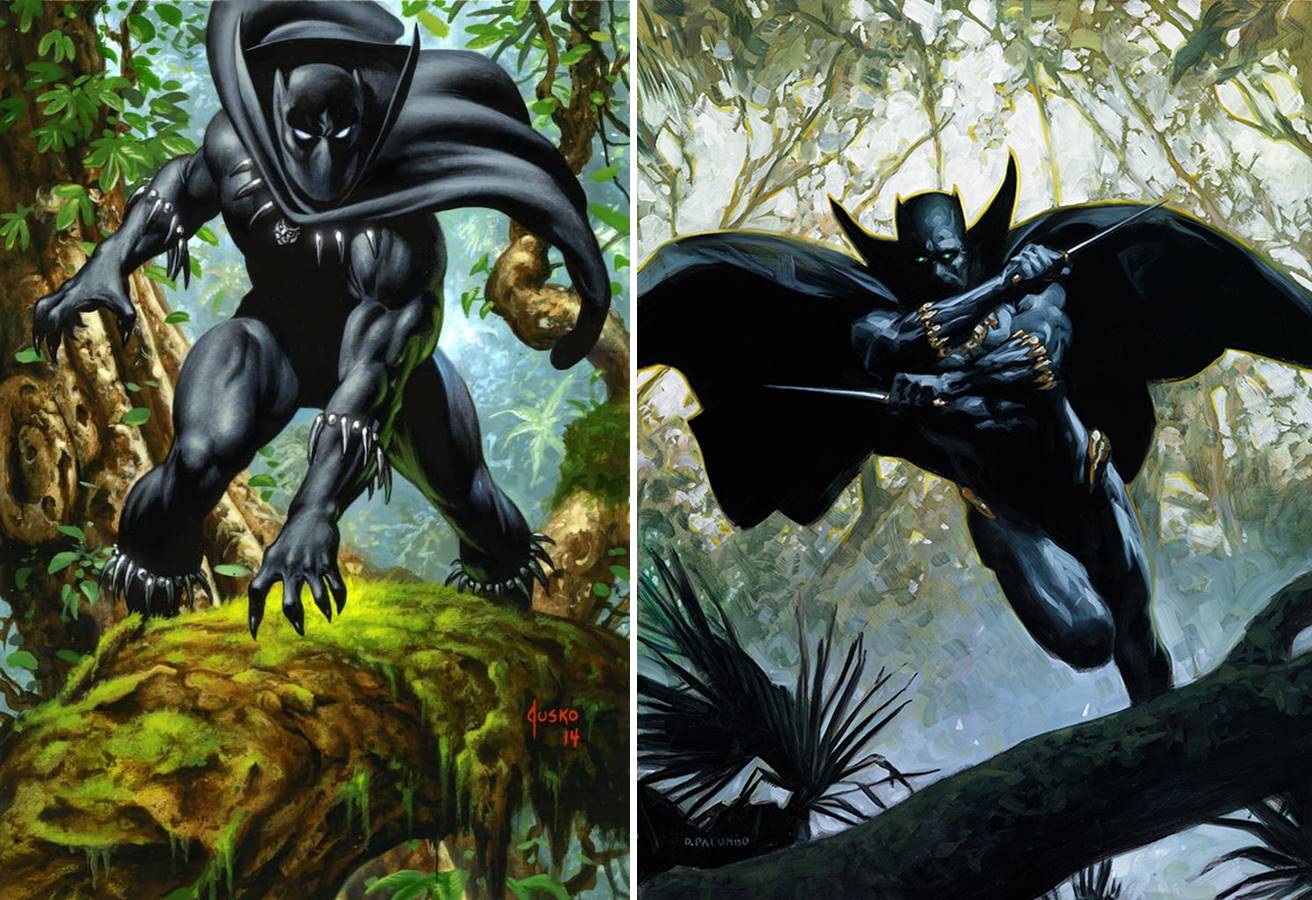
Left: Black Panther (Base) by Joe Jusko, 2016. Right: Black Panther by Dave Palumbo, 2020.
We’ll begin in the jungles of Wakanda, and both of these works place T’Challa deep within the jungle of his home country. Similar in costume, each painting has the character in motion and ready for action. In case you weren’t aware, each of Palumbo’s works has an accompanying soundtrack and Black Panther’s, Mombasa by Hans Zimmer from the movie Inception, is a perfect fit. Take a listen, and watch this song bring the painting to life.
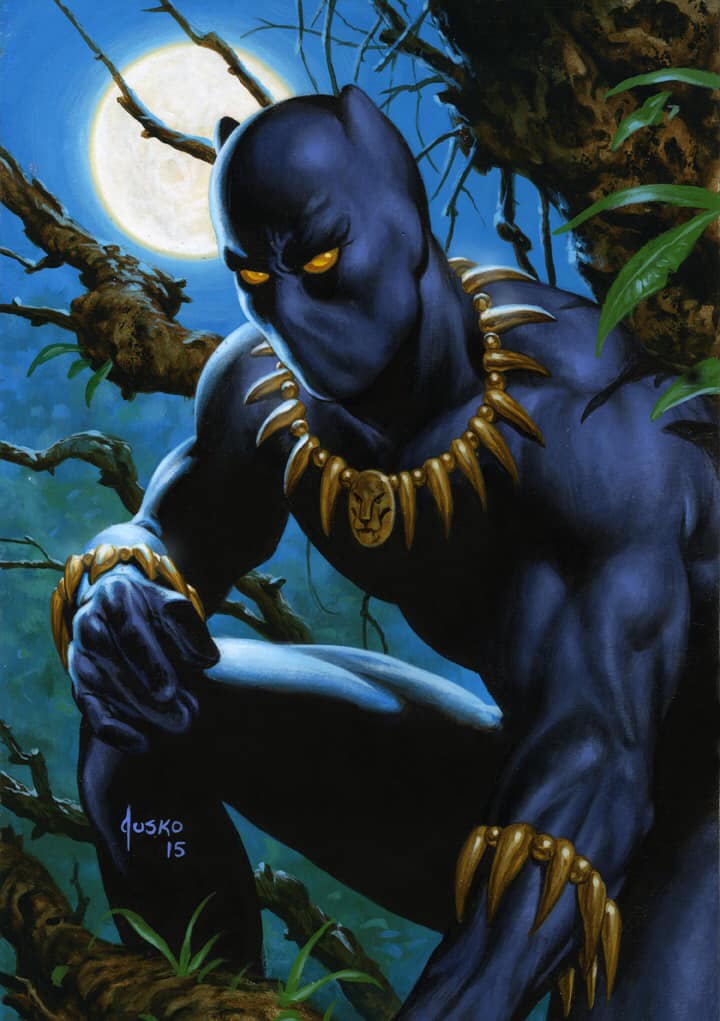
Black Panther (Holofoil) by Joe Jusko, 2016
Jusko mentions in his book that he severely disliked including the cape—wouldn’t it get stuck on a limb? We see in his other Black Panther, created for the Holofoil insert series, that he has lost both his cape and claws in exchange for a contemporized costume and a much more peaceful and pensive depiction within a moonlight treetop. It’s completely different from the previous two we’ve seen, and still different from the other two to come, where T’Challa heads to a different kind of jungle.
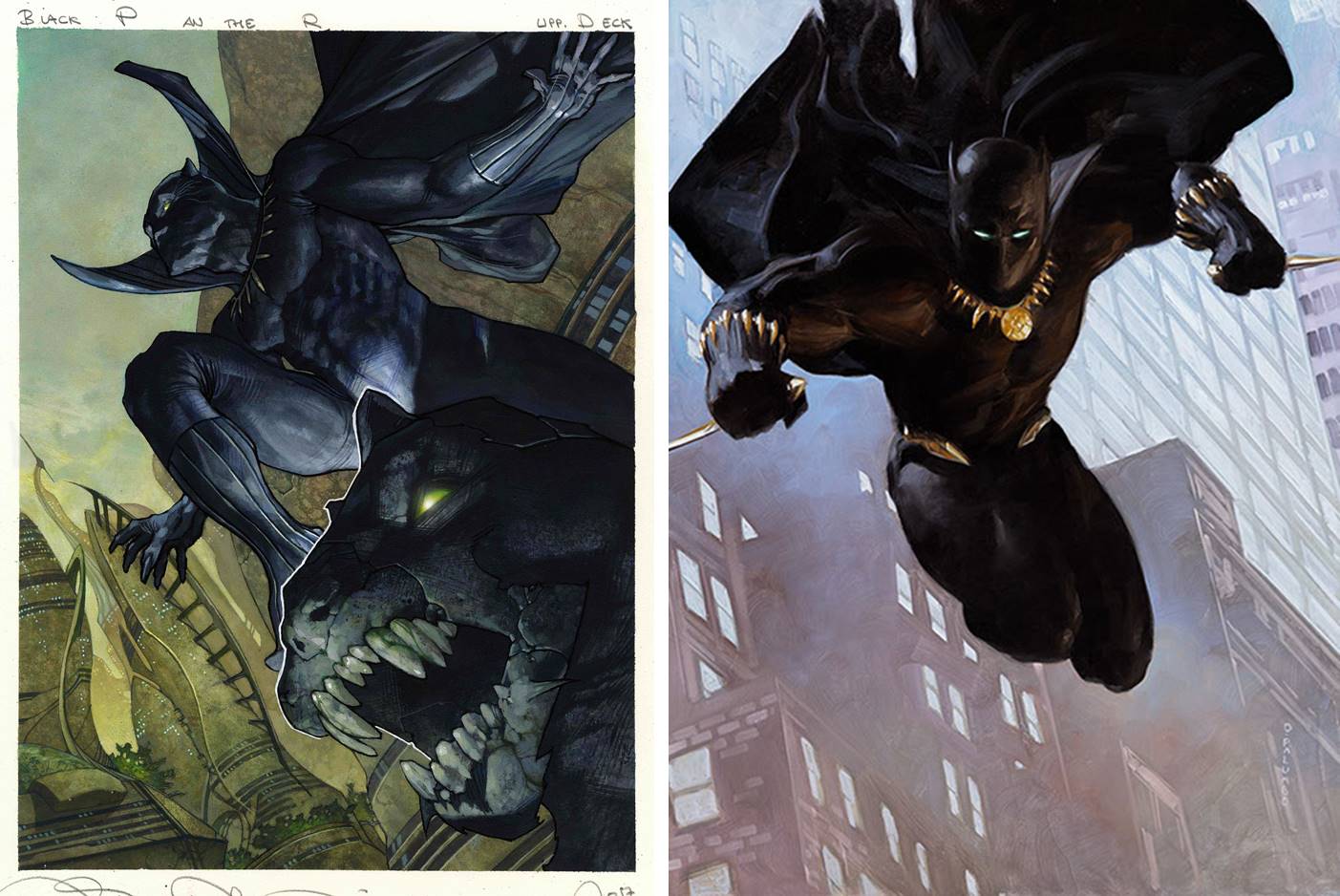
Black Panther by Smone Bianchi, 2018. Right: Black Panther (Canvas Gallery) by Dave Palumbo, 2020.
The final two Black Panther paintings, for the base set of 2018 and the Canvas Gallery series of 2020, show our feline friend within the concrete jungle, far away from the forests of Wakanda. Bianchi’s power pose atop a panther-esque gargoyle brings back some serious 1990s superhero nostalgia. And Palumbo shows the Panther descending from a tall building, as if we’re standing at a skyscraper window and he passes by on his way down to save the day. A moment frozen in time like a snapshot.
Hawkeye
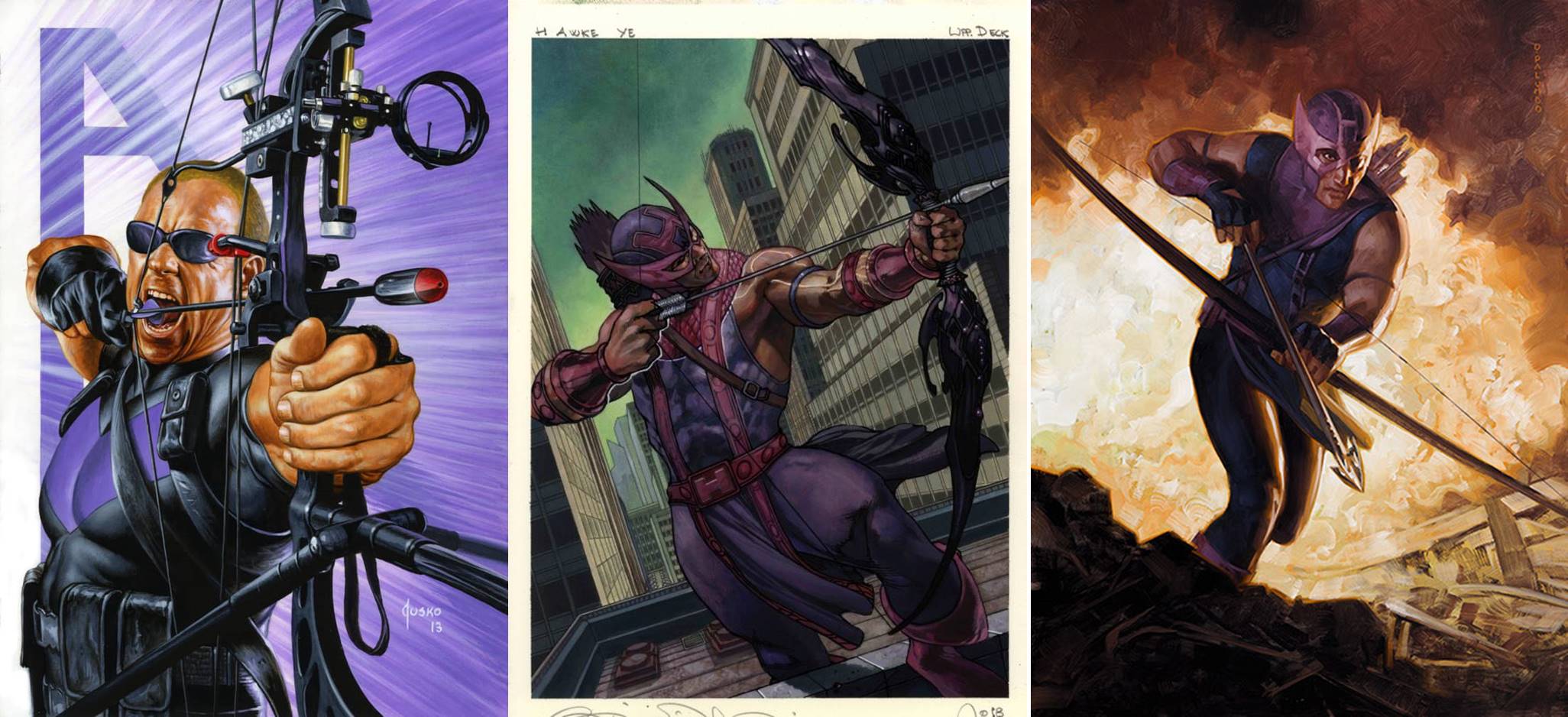
Left to right: Hawkeye by Joe Jusko, 2016; Hawkeye by Simone Bianchi, 2018; Hawkeye by Dave Palumbo, 2020.
Hawkeye has only a single showing in each set, and for the most part, we find the same character depicted in each one. (Here’s waiting for the day we get Kate Bishop!) Jusko’s Clint Barton is up close and personal, with an incredibly detailed bow and emotion-filled expression; it’s as if we’re Ant Man standing upon his bow, ready to be fired away. Bianchi zooms out and quiets the work, a depiction of sheer concentration amongst the cityscape as he draws back a very different type of bow. And Palumbo’s work tells a story as our hero, in his vintage mask, flees destruction behind him. We know not whether he’s caused it, but we can be certain he’s headed for more action.
Dr. Strange
Not unlike Black Panther, Dr. Strange appears two ways (ish) across these three sets
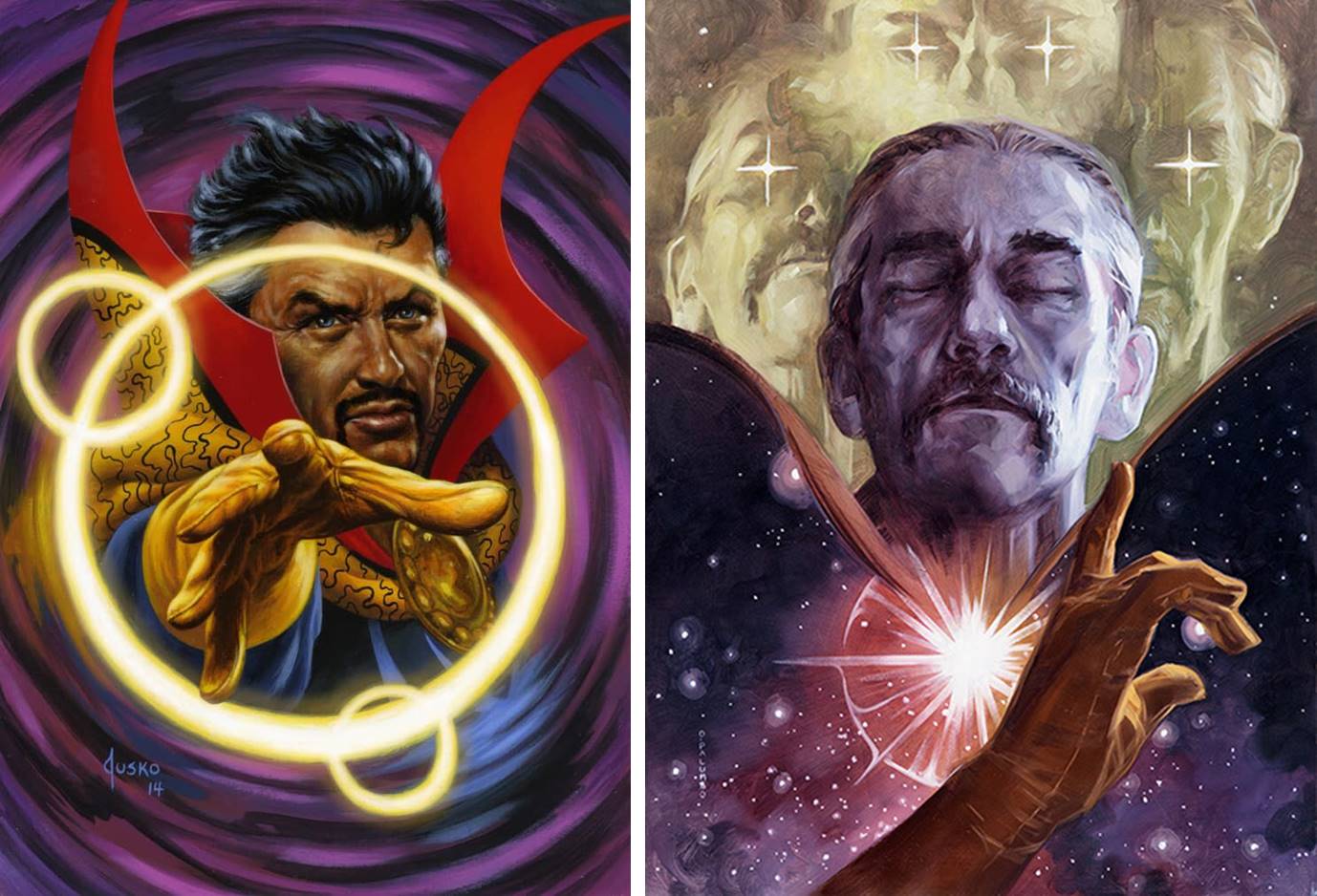
Left: Dr. Strange (Holofoil) by Dave Palumbo, 2020. Right: Dr. Strange (Base) by Joe Jusko, 2016.
In the base set of 2016 and Holofoil insert set of 2020, we get up close and personal with the good doctor, transported into another dimension and witnessing the full spectrum of his power. Jusko’s swirling vortex and Palumbo’s otherworldly galaxy take us out of our own bodies, and we get a taste of why Strange is indeed the Sorcerer Supreme. These are solemn but oh so very strong.
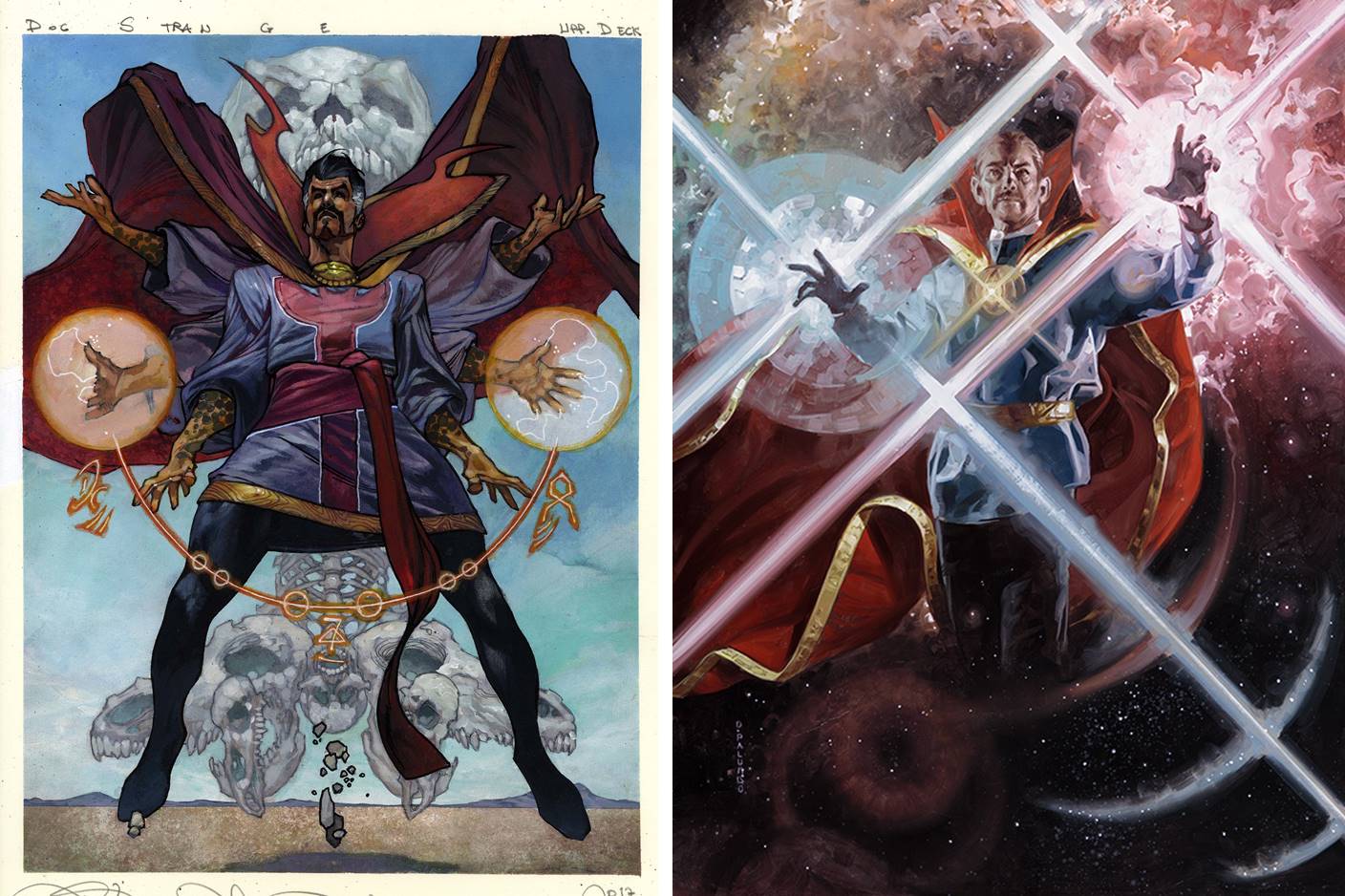
Left: Dr. Strange by Simone Bianchi, 2018. Right: Dr. Strange (Base) by Dave Palumbo, 2020.
Dr. Strange can also be found at full size too, and the display of his powers comes right along. Bianchi gives up the Doctor at warp speed and mid-spell, multiple arms and everything, while Palumbo presents fellow artist Allen Williams as the model for Stephen Strange. You must look closely at his legs—there is no bottom half, because he’s come to us again, transported through multiversal time and space. How cool is that?
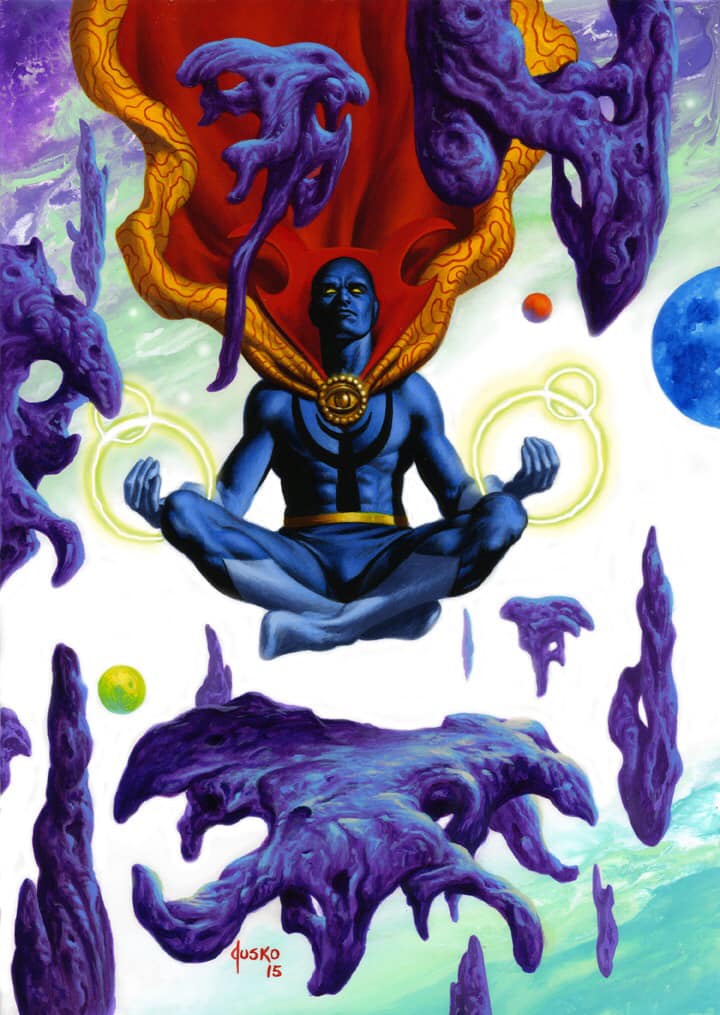
Dr. Strange (Holofoil) by Joe Jusko, 2016
If things couldn’t get any Stranger…Jusko painted one other Strange for his set, a Holofoil version, and one that presents him quite differently! For a short time, Dr. Strange wore a mask in the comic series in an effort to help him appear more as a traditional superhero and to help struggling sales. This would ultimately be abandoned when the character was revived, and the mask-less doctor would return as most of us know him, but Jusko gives the world a little glimpse into what could have been a very different legacy for the character.
Vision
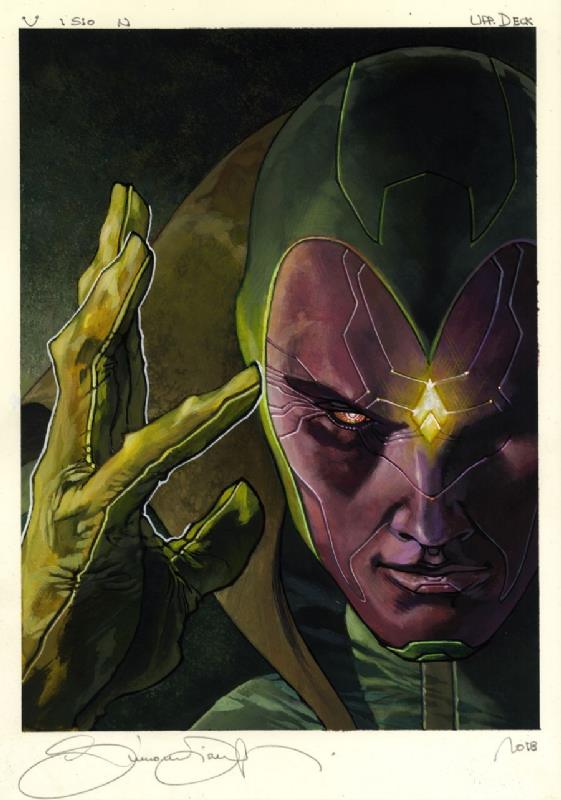
Vision by Simone Bianchi, 2018
Bianchi’s Vision is the only close-up, a bust of sorts that emphasizes the two most important parts of who Vision is: the Mind Stone implanted within his head, aglow and crackling with energy, and his hand from which that power flows forth. The darkened background sets an ominous tone Bianchi is known for, and makes us question whether Vision may be friend or foe.
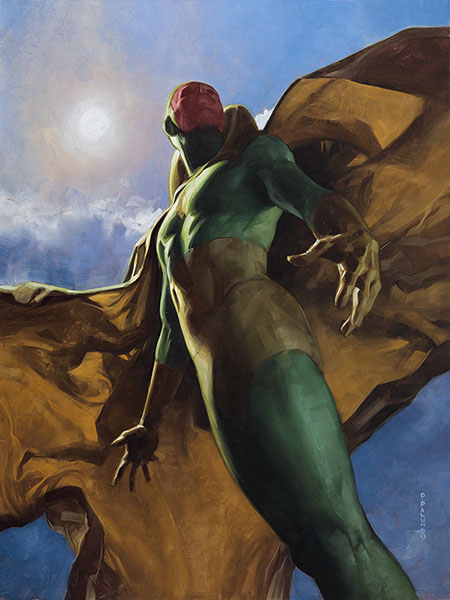
Vision by Dave Palumbo, 2020
Palumbo looked to the palette and mood of legendary artist NC Wyeth, and presents the character in a strong but serene upward angle, against the sun and what feels as if it could be an ever-imminent lens flare. The capture of the billowing cap is simply breathtaking, and though simple and straightforward, this is one of my favorite pieces of his entire set.
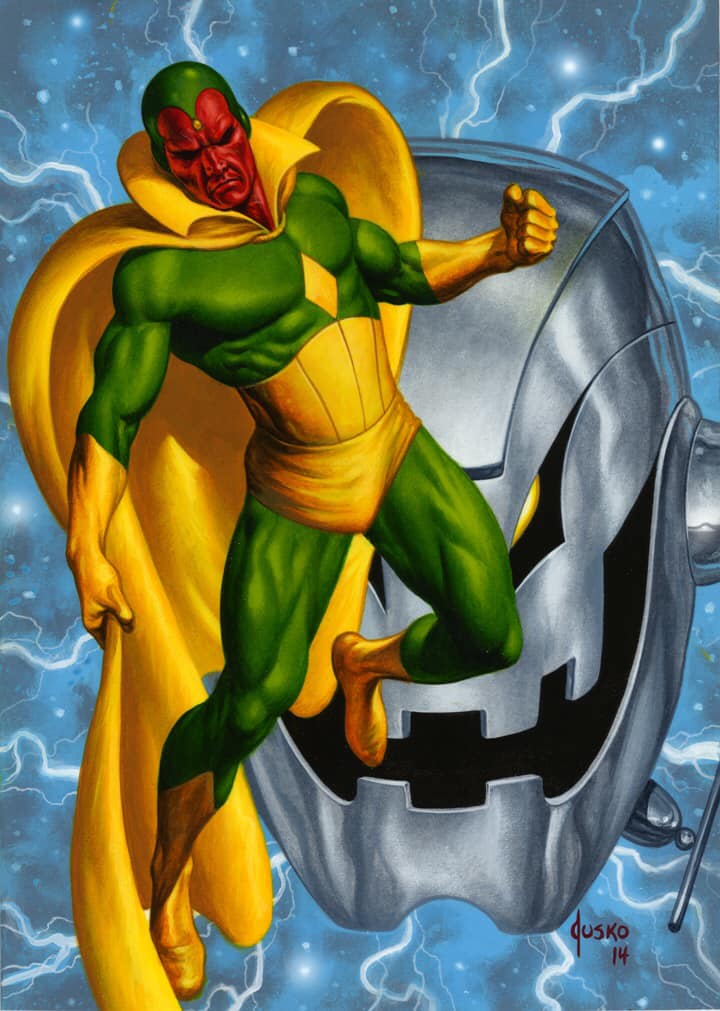
Vision by Joe Jusko, 2016
I want to end with this work, namely because of the caption that accompanies the painting in Jusko’s Marvel Masterpieces book. The story goes:
“I bought Avengers #57 & 58, the very first appearance of The Vision, from a kid in an NYC playground when I was eight years old. By the time I finished reading those two issues, I knew what I wanted to do with my life. It’s a revelation that sounds absurd, but from then on all I did was draw with the unwavering goal of making comics my career.”
The Vision is the reason why we have Joe Jusko illustrating Marvel Masterpieces at all, and I think that’s pretty incredible stuff.
Wrapping Up
Stepping back from this set of artwork, we can draw a lot of similarities and universals from how the artists chose to capture their heroes. Whether it’s similar environments, displaying certain characteristics, or simply costume choice, these consistencies remind us that we’re looking at things within the same world. And yet each artist has told a different story based on who, or what, or how they’ve presented someone. It’s what makes Marvel Masterpieces truly special: you’ve no doubt what you’re looking at, and yet each character and artist is different, and there is so much to see when you look close.
Next time in Masterpiece Theater we’ll finish up this Avengers mini-series and look at some of the team’s most dastardly enemies, and I promise I haven’t forgotten about our other two larger than life members: their turn is coming soon.. And while we wait for that, don’t forget I’ll have the second Quarterly Report of the currently releasing Marvel Unbound set by fred.ian as well. You can keep up with all things Marvel Masterpieces 2020 by following me on Twitter. Feel free to ask questions or retweet to continue the conversation. Thanks and see you next time!
Donny Caltrider has been playing Magic since 2002 and collecting original Magic art since 2017. He has an M.A. in Museum Studies from Johns Hopkins University and enjoys telling stories about art, objects, and the intersection of fantasy with real-life. You can find him on Twitter talking about #mtgart, museums, and other #vorthos related goodness. Follow along and continue the conversation!

